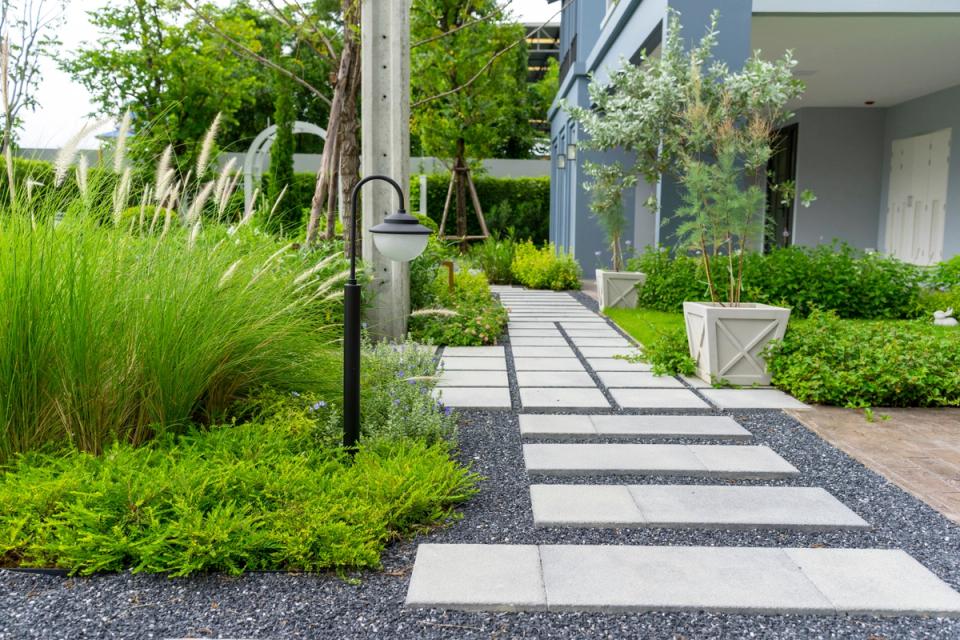
Creating a beautiful and functional outdoor space involves more than just planting flowers or laying down pavers. A well-balanced yard incorporates both hardscaping (non-living elements like patios, walkways, and retaining walls) and softscaping (living elements such as plants, trees, and grass). Striking the right balance between the two enhances curb appeal, increases property value, and ensures long-term sustainability. This guide explores the differences, benefits, and strategies for finding the perfect hardscape-softscape balance in your landscape design.
Understanding Hardscaping and Softscaping
What is Hardscaping?
Hardscaping consists of permanent, non-living features that structure an outdoor space. These elements provide durability, reduce maintenance, and improve accessibility.
Common Hardscaping Features:
- Patios and Decks: Ideal for outdoor entertainment and relaxation.
- Walkways and Pathways: Define movement within the yard while adding elegance.
- Retaining Walls: Prevent soil erosion and create visual interest.
- Fences and Gates: Add privacy and security while defining boundaries.
- Driveways and Paved Areas: Provide functional and aesthetic benefits.
- Pergolas and Gazebos: Offer shade and a stylish architectural element.
What is Softscaping?
Softscaping refers to the living, organic components of landscaping. These elements add beauty, texture, and environmental benefits.
Common Softscaping Features:
- Lawn and Grass Areas: Provide an open, green space for recreation and relaxation.
- Flower Beds and Gardens: Introduce color, fragrance, and visual appeal.
- Trees and Shrubs: Offer shade, privacy, and seasonal beauty.
- Ground Cover Plants: Reduce soil erosion and minimize maintenance needs.
- Climbing Plants and Vines: Enhance vertical spaces and add natural charm.
Benefits of Balancing Hardscaping and Softscaping
A well-designed landscape incorporates both elements to create harmony, functionality, and aesthetic appeal.
1. Enhanced Curb Appeal
A thoughtfully designed yard looks polished and inviting. The contrast between natural plant life and structured hardscape elements makes a property more visually appealing.
2. Increased Property Value
Homes with attractive and well-maintained landscapes have higher resale values. Hardscaping improves durability, while softscaping adds charm and warmth.
3. Improved Functionality
Hardscaping elements like patios and pathways create usable spaces for outdoor activities, while softscaping provides greenery and environmental benefits.
4. Reduced Maintenance
A balanced landscape design minimizes upkeep. Hardscape features require little maintenance, and drought-resistant plants or native vegetation reduce watering needs.
5. Environmental Benefits
Softscaping improves air quality, provides habitat for wildlife, and helps manage rainwater runoff. Hardscaping, when used wisely, prevents erosion and enhances accessibility.
Strategies for Achieving the Perfect Balance
Finding the right ratio of hardscaping to softscaping depends on climate, space, personal preferences, and intended use of the outdoor area.
1. Start with a Design Plan
Before making changes, sketch out a plan that includes both hardscape and softscape elements. Consider traffic flow, seating areas, plant placements, and focal points.
2. Define Key Areas
- Entertainment Spaces: Use patios or decks for outdoor gatherings.
- Garden and Greenery Zones: Dedicate areas for plants, flowers, and trees.
- Functional Pathways: Ensure easy navigation with well-placed walkways.
- Privacy and Borders: Use fencing, hedges, or retaining walls for privacy.
3. Use Hardscaping to Enhance Softscaping
Hardscape features should complement softscape elements rather than overwhelm them. For example, a stone pathway winding through a lush garden enhances visual appeal without disrupting nature’s flow.
4. Incorporate Eco-Friendly Solutions
- Permeable Pavers: Allow water to drain naturally, reducing runoff.
- Drought-Tolerant Plants: Reduce water usage while maintaining beauty.
- Rain Gardens: Collect rainwater for sustainable irrigation.
- Mulching: Helps retain soil moisture and suppress weeds.
5. Consider Seasonal Changes
Choose plants that provide year-round interest and ensure hardscape elements are durable enough to withstand various weather conditions.
Common Mistakes to Avoid
Achieving balance requires careful planning. Here are some pitfalls to watch out for:
1. Overloading with Hardscape Features
Too much hardscaping can make a yard feel sterile and unwelcoming. Counterbalance hard surfaces with greenery, flower beds, or climbing plants.
2. Ignoring Maintenance Needs
Softscape elements require upkeep, while hardscape features can degrade over time. Consider long-term maintenance before finalizing designs.
3. Poor Drainage Planning
Hard surfaces can cause water runoff issues if not designed properly. Ensure drainage solutions are in place to prevent pooling and erosion.
4. Choosing the Wrong Plants
Plants should match the climate, soil type, and sun exposure of the yard. Native plants are often the best choice for low-maintenance landscaping.
5. Lack of Cohesion
Your outdoor space should have a seamless flow. Disjointed designs with mismatched elements can feel cluttered and unappealing.
Professional Assistance for a Balanced Landscape
If you’re unsure how to balance hardscaping and softscaping, consulting a professional landscaper can help. Experts assess soil conditions, drainage, and overall design to create a harmonious and practical outdoor space.
When to Hire a Professional:
- If you need structural hardscape elements like retaining walls.
- If you’re unsure about plant selection or garden layouts.
- If drainage issues need to be addressed.
- If you want a high-end, cohesive design that maximizes property value.
Crafting Your Outdoor Sanctuary: Final Insights
Balancing hardscaping and softscaping is essential for a beautiful, functional, and sustainable landscape. By combining the structure and durability of hardscaping with the natural beauty and ecological benefits of softscaping, you can create an outdoor space that enhances your home’s appeal and usability. Whether you’re starting from scratch or updating an existing yard, thoughtful planning ensures a landscape that remains stunning and practical for years to come.